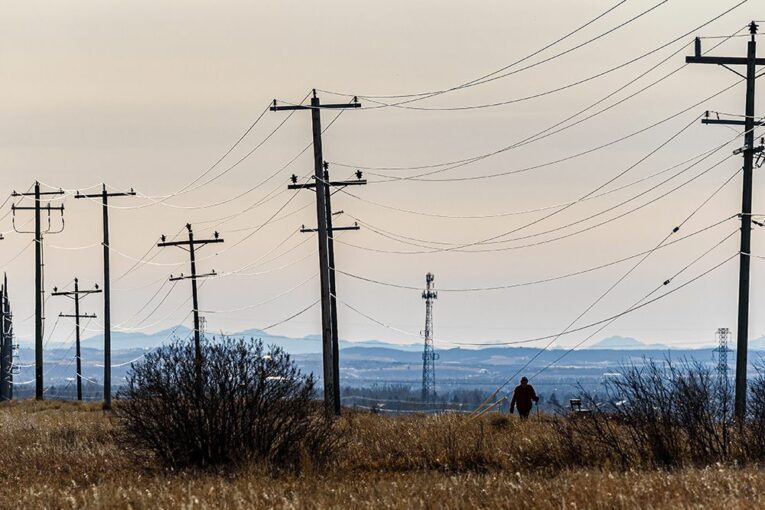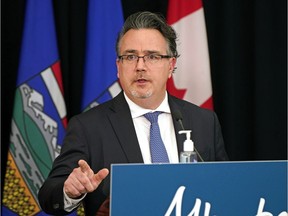
For consumers, electricity matters most when it doesn’t work at critical times — or when prices spike.
As Ottawa moves forward with its plan for Canada’s electricity grid to reach net-zero emissions by 2035, Alberta power generators say the federal government needs to focus not only on clean energy, but also on ensuring there are affordable and reliable supplies available in the future.
“They need to think of the market as a three-legged stool,” said John Kousinioris, CEO of Calgary-based TransAlta Corp.
“The three legs are reliability, we need to make sure that it’s affordable and we need to make sure that it’s clean. So our biggest concern would be that, at times, there is a focus on only one leg of the stool, for example, clean — potentially at the expense of reliability or affordability.”
As part of Canada’s commitment made at the COP26 climate conference last year, the federal government vowed to move the country’s electricity grid to net-zero by 2035.
The Liberal government recently launched the second round of public engagement on its Clean Electricity Regulations (CER), with feedback accepted until next week.
The country’s electricity grid is already more than 80 per cent non-emitting, with large hydropower resources available in provinces such as Quebec and Manitoba, nuclear power used in other parts of the country, and renewable supplies expanding.
In Alberta, more wind and solar projects are taking off, although natural gas-fired generation remains essential.
At the end of last year, purely gas-fired generation made up 59 per cent of the province’s installed generation capacity, according to the Alberta Electric System Operator (AESO).
According to the new federal document on the regulations, the government is considering moves to support reliability and affordability.
It includes allowing unabated natural gas-fired generation (units without carbon capture and storage) to continue after 2035 “during emergency circumstances,” instead of having to shut down.
It would phase in regulatory requirements and allow newer gas-powered units built prior to the regulations being published to operate past that time for “a short, prescribed period.”
“The decision to commission a new unit after 2025 will need to take into consideration the CER obligations,” it states.
The document says existing gas units that reach the end of their prescribed life could provide backup to renewable electricity, under certain conditions.
Industry leaders are studying the information carefully, but believe progress is being made.
Capital Power CEO Brian Vaasjo said the new proposals recognize natural gas is necessary for the sector.
“It’s a great starting point for discussions with industry,” he said in an interview Wednesday.
“For plants that are existing today, there really are no implications until 2035. That’s very positive, in very stark contrast to the discussions that have taken place previously.”
Evan Bahry, executive director of the Independent Power Producers Society of Alberta, said the group is seeing “important and welcomed new language” in the document that should provide generators with greater flexibility heading into 2035 and beyond.
Critics, including the Alberta government, remain worried about the effect of the transition on power prices and system reliability.
In June, a report issued by AESO concluded there are “multiple pathways to achieve net-zero emissions” in the province’s power system, but warned of potential additional costs and necessary investments reaching $44 billion to $52 billion by 2041.
“If the federal government does not recognize Alberta’s unique electricity market (structure) and lack of access to abundant hydroelectric power, their proposal will result in significant new system costs that will ultimately be borne by consumers,” Dale Nally, Alberta’s associate minister of electricity, said in a statement.

Industry officials appear less critical, waiting to see how the regulations progress.
For Canada to meet its objectives, it will require adopting an “all-of-the-above” approach that uses solar, wind, hydro, storage and natural gas, Kousinioris said.
“It isn’t just about clean,” TransAlta’s CEO said during a conference call Friday with analysts and journalists.
“You can have a very clean grid but if nobody can afford it, I’m not sure that you’ve met your objective.”
The Pembina Institute says its analysis indicates a clean energy portfolio that includes renewable power, storage, energy efficiency, demand-side management and transmission between jurisdictions can be cheaper than using gas-fired electricity generation.
Binnu Jeyakumar, the institute’s director for clean energy, said the new regulations are critical for Canada because the pathway for many sectors to decarbonize will be reached through increased electrification, such as in the transportation industry.
“What we need is some certainty, and that is what this regulation provides,” she said.
The industry is examining various options to reach the 2035 goal, such as investing in more renewable projects, hydrogen, and carbon capture and storage initiatives.
At Capital Power, the company is exploring a $2-billion carbon capture and storage project at its Genesee Generating Station west of Edmonton.
The company is undertaking a front-end engineering study with its project partners. The development would capture 95 per cent of the emissions from its Genesee 1 and 2 units, which are in the process of being repowered to fully use gas and move off of coal.
Vaasjo anticipates the project’s final investment decision will occur in the first half of 2023, potentially capturing and storing emissions underground in 2027.
“Every indication is that at the end of the day, we’ll be very satisfied with both the technology and the cost,” he said.
And can Canada get to its goal of a net-zero grid by 2035 and still have affordable and reliable electricity supplies?
“Do I think that we can substantially decarbonize the grid between where we are today and where aspirations are trying to go to in 2035? I think the answer is yes . . . The challenge that we see is that last 10 per cent of emissions reductions,” said Kousinioris.
“It’s just being mindful of that three-legged stool as we get to that tail of getting to success.”
Chris Varcoe is a Calgary Herald columnist.
You can read more of the news on source
